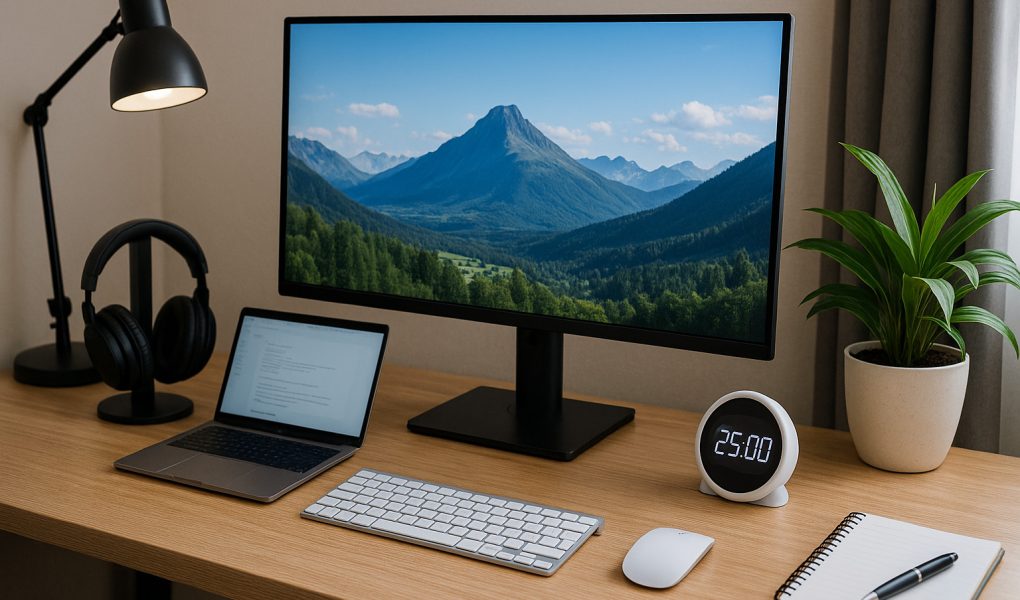A cluttered or uninspired workspace often reflects directly on performance. A smartly designed desk setup isn’t just about looking tidy—it creates flow, reduces friction, and helps you stay consistent. Here’s a breakdown of what truly matters in a home office, especially if you want to stop chasing productivity and start owning it.
1. The Right Desk: Size, Shape, and Purpose
Function drives form. A desk should match your work habits. Writers or coders benefit from wide, minimalist surfaces. Creatives might need extra shelving or space for tablets and sketchbooks.
Key points to prioritize:
- Depth: At least 24 inches to allow monitor distance and arm comfort.
- Shape: Straight for simplicity; L-shaped for multitaskers.
- Material: Wood and metal combos strike a balance between durability and comfort.
A desk that’s too small becomes a source of stress. A desk too large invites clutter. The right dimensions make all the difference.
2. An Adjustable Chair That Actually Supports You
Forget aesthetics for a moment. Your chair is a tool, not decor.
Non-negotiables in a solid work chair:
- Adjustable seat height, backrest angle, and armrests.
- Lumbar support that doesn’t shift out of place after an hour.
- Breathable material like mesh or cushioned fabric—leather gets sticky in longer sessions.
An office chair isn’t a place to settle for “good enough.” It’s the one item that has direct, daily impact on your spine and focus.
3. External Monitor: Visual Real Estate That Pays Off
A single laptop screen slows you down. A larger external monitor—or two—lets you multitask without switching tabs constantly.
Ideal specs:
- 27 inches or larger
- IPS panel for better color accuracy and wider viewing angles
- 4K resolution if you’re working with graphics, video, or spreadsheets
Even writers and marketers see a noticeable drop in fatigue when they aren’t hunched over a 13-inch display.
4. Keyboard and Mouse: Stop Using Your Laptop’s Built-In Options
Built-in laptop keyboards and trackpads weren’t designed for all-day typing.
Recommended upgrades:
- Mechanical keyboards for tactile feedback and durability
- Ergonomic mice to reduce wrist strain
- Wrist rests if you’re logging long hours typing
These tools improve posture and minimize repetitive strain, especially during deadlines.
5. Lighting: Natural and Artificial Balance
Bad lighting causes eye strain, headaches, and sluggish mood. Most setups ignore this and rely solely on overhead lights or a dim laptop glow.
Fix this with:
- A desk lamp with adjustable brightness and temperature
- Positioning your desk near a window (but not with the monitor facing it)
- Using warm light during the day and amber light post-sunset
Lighting is part productivity, part energy management. Get it right, and your focus lasts longer.
6. Noise Management: Cancel or Control
Distractions break rhythm. Whether it’s barking dogs, traffic, or chatty neighbors, background noise disrupts more than you realize.
Options to consider:
- Noise-canceling headphones for full isolation
- White noise machines or apps for ambient consistency
- Acoustic foam panels for echo reduction in bare rooms
Silence isn’t always realistic. But controlled sound keeps your brain on task.
7. Time Management Tools: Simple but Effective
One of the biggest traps of working from home is time drift—those minutes lost checking email, scrolling social media, or reading “just one more thing.”
A browser-based Pomodoro timer offers a structured method to split work into focused 25-minute blocks with 5-minute breaks. No app installation needed. No complicated sign-ups. Just a focused tool that helps you get through your to-do list without burnout.
Use it for writing, planning, editing, or admin tasks. Set it up, press start, and let it run in the background. Simplicity helps.
8. Cable Management: Hide the Chaos
Cable clutter isn’t just ugly—it catches dust, causes snags, and creates mental noise.
Tame it with:
- Under-desk trays or raceways to guide cables neatly
- Velcro wraps or zip ties to group cords by function
- Cable clips to keep chargers and adapters from falling behind furniture
Fewer distractions. Easier cleaning. More room to think.
9. Plants: Low-Maintenance Energy Boosters
Plants are proven to reduce stress, increase happiness, and slightly improve air quality. They’re also a visual break from screens and text.
Top picks for workspaces:
- Snake plant – thrives in low light, barely needs water
- ZZ plant – nearly indestructible
- Spider plant – fast-growing and cheerful
Choose one or two. You don’t need a jungle. You just need green in your line of sight.
10. Extras That Actually Pull Weight
Not everything in your workspace needs to have a glowing review or a five-star badge. But every item should have a reason.
Ideas that serve real use:
- Footrests to support posture during long sessions
- Dry-erase boards for brain dumps, goals, and quick reminders
- Bookshelves within reach for your work-related materials
Every item either contributes to your work or gets in the way of it. If it doesn’t help, move it out.
A work-from-home desk isn’t just about buying the most expensive gear or copying Instagram setups. It’s about designing a space that works for your brain, body, and workflow. Start with the basics, add thoughtfully, and build a setup that doesn’t just look productive—but actually is.
